This 12.5 x 8 cm notebook is bound in red leather with the border blind embossed: the hinge to the brass clasp is missing. The front of the notebook has a label of cream-coloured paper (6.8 x 4.0 cm) with 'Cape de Verds Fernando Noronha Bahia Abrolhos Rio de Janeiro City' written in ink. The notebook is 112 pages long. Entries are written in two sequences, one from the front cover (pp. 1a-27a), the second from the back cover (pp. 1b-85b).
[front cover]

Cape de Verds
Fernando Noronha
Bahia Abrolhos
Rio de Janeiro City
[inside front cover]
C. Darwin
13/4
35
20
26 — 20
63 - 20 60 — 30
26 - 30
[Several calculations, almost illegible, on calculating the height of a Baobab tree]
= + + -
BC : CA : : r : t Ð b
11, 95 4 2 4
10. 30 2 5
1. 65 19 0 1
45 39 14 28

[right angled triangle for calculating height of Baobab tree]
[page 1a]
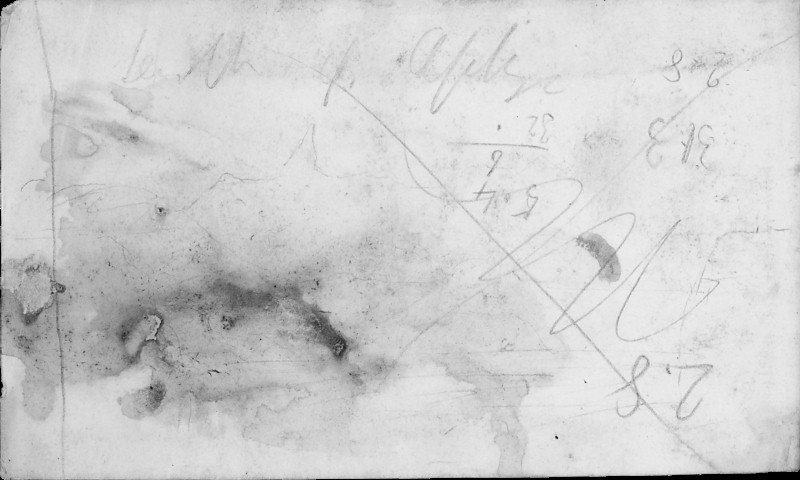
[possible sketch of a coastline or mountain range]
2.8 5.4
6
36.3 32
2.8
[page 2a]
Tops of prickles scarlet red & other parts tile red1
Don Manuel Rodriguez y da Silva Ponseca
1 Asterias, specimen not in spirits 140 in Zoology notes, p. 370.
[page 3a]
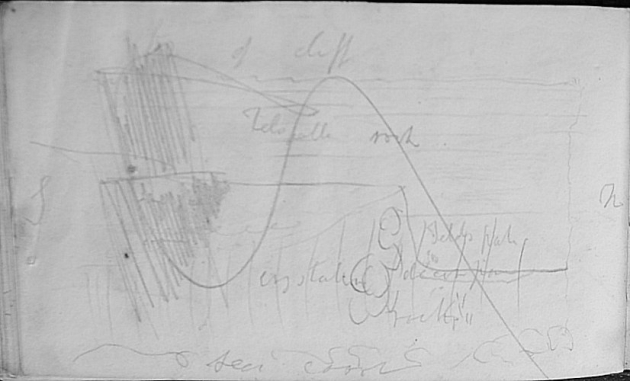
[geological sketch section of cliff]
S top of cliff Feldspathic1 rock Feldspar2 Crystalline decompose rock sea coral3 N
1 Containing noticeably abundant quantities of feldspar minerals.
2 Name given to a group of very common silicate minerals usually whitish in colour occurring in crystals or crystalline masses.
3 Marine invertebrate animal with radial symmetry, often in colonies called reefs.
[page 4a]
Baobab1 6 ¾
high ½ strap Strap
5" 4
shadow 9 & per 0 ½ 12
base 90 feet 26° ½ 12 ½
90 from trees first position
1 The Adansonia tree of Africa.
[page 5a]
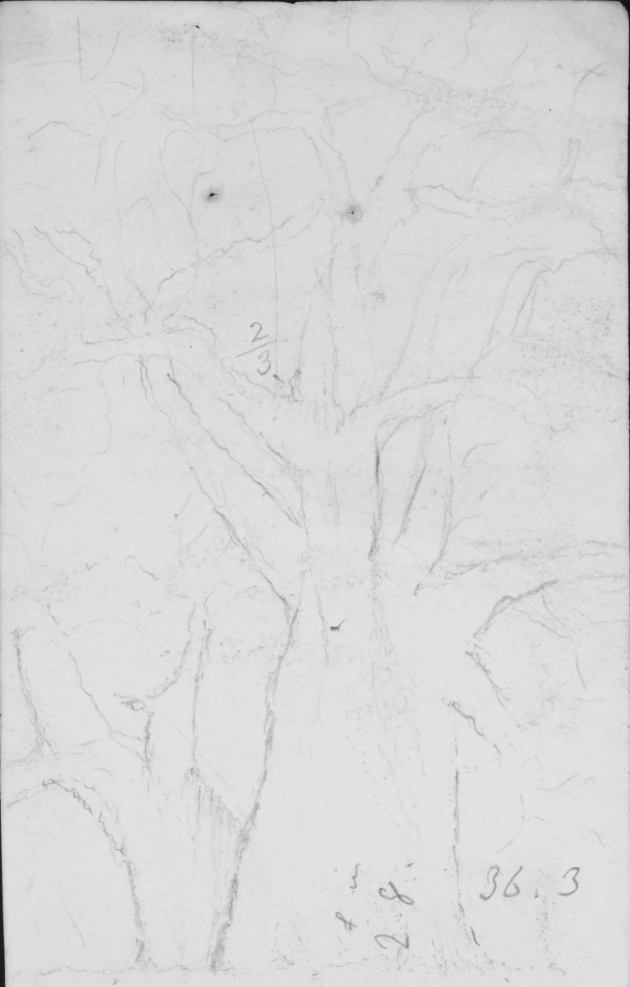
[drawing of Baobab tree by FitzRoy?]
⅔ ft 8in 36.3
[page 6a]
Cliff 42 feet Sand 28.3
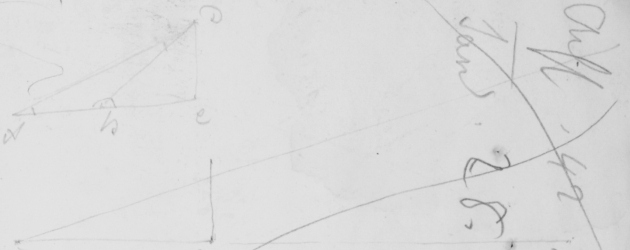
[mathematical sketch of triangle] A B C D
[page 7a]
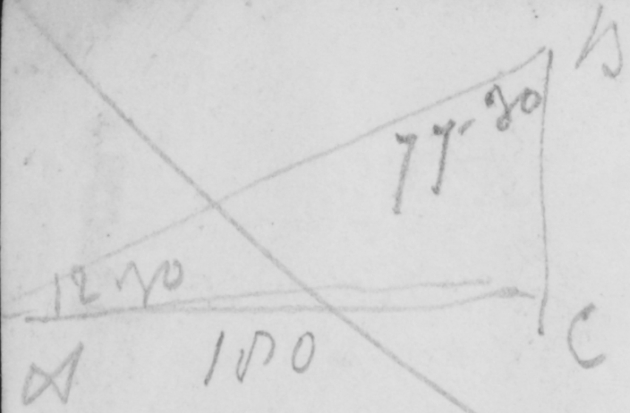 |
A B C 180 12 30 77 - 30
= + + -
BC : CA : : r : + ∠ B |
n 45 Diam 13 Circum 2 feet from the ground 35 [feet]
13| 45.0 (3.4
39
60
52
12, 2 5 5 2 7
10, 6 5 4 2 4
2, 6 0 1 0 3
29
[page 8a]
45 feet high
Lobularia1 coating 15 & intermediate 15
Brick in modern Breccia2
Fistularia3 squirt white threads from anus.
Cavolina long horns4
1 Lobularia or dead men's fingers is a soft coral of order Alcyonacea. See Zoology notes, p. xvi
2 A composite rock consisting of angular fragments of stone, etc., cemented together by some matrix such as lime: sometimes opposed to conglomerate in which the fragments are rounded or water-worn.
3 An echinoderm of order Apodida, specimen 61 in Zoology notes, p. 12.
4 An aeolidacean nudibranch, specimen 56 in Zoology notes, p. 11.
[page 9a]
= 4th
Hill 1 E of North concentric crystalline white marble1 &c
[illeg] conglomerate2 above trap3 hills
[Corundum] hills
F R overlies [Trap] from hill
1 A metamorphic rock derived from limestone.
2 A coarse sediment in which the fragments are rounded (often opposite of breccia).
3 Trappean: hard, splintery lava. Derived from 'trappa', meaning steps in Swedish and referring to the step-like scenery associated with this rock.
[page 10a]
Brick in modern Breccia
Kingfisher eating lizard Mac C1
Milk cream for [animalcule]
Shells action under blowpipe try the old ones
Crabs that run & leap
Milk from goat on 7th [February 1832] examined on 11th composed of small animalcule about .0001 in diameter
Dineutes of MacLeay2
1 Robert McCormick (1800-1900), Surgeon on the Beagle 1831 - April 1832. Not, as modern writers have claimed, the default or official naturalist on the Beagle.
2 See Darwin's insects, p. 46: '213. 214. Gyrinus allied to Dineutes MacLeay (?) Hab Do. [Cape Verde Islands]' William Sharp Macleay (1792-1865), naturalist and diplomat who devised the Quinary System of classification in which the five main animal groups are represented by 'circles of affinity'.
[page 11a]
N Pt 29 — 97
Capa 1/33 35/1
Temp 66°
(Blue colour)
Sounding 23/1
fathoms
26 Lat
Sea only in patches R in diameter
microscope showed small globules floating & transparent irregular shaped [fluids] in the water.1
1 See 'Oily matter on sea', Zoology notes, p. 31.
[page 12a]
patches uniting & joining — showing irridescent colours
26th [March 1832] 10. am 82° 41 M 82° 101 M 81
2° 21' S E Bahia.
West 60 ½ 200/1 between 230/1 & 30 bottom
30/1 230/1 250/1
18° 6' S
2° 21' E of [Bahia] 38 30 2 40° 54'
36° 6' W
30/1 230/1 250/1 ¾ & 7 = 21 [divided by] 4 [=] 5
About 20 ½
[page 13a]
27th [March 1832]
½ past 8 am |
180/1 |
81° |
⅔ |
— 9 am |
150/1 |
81 |
⅓ |
— 10 am |
200/1 |
81 |
¼ |
½ pa 11 am |
250/1 |
81 |
½ |
¼ pa 1 pm |
250/1 |
81 |
⅔ |
¼ pa 2 pm |
30/1 |
81 |
⅔ |
3 pm |
bottom 20 |
81 |
⅔ |
4 pm |
bottom 22 |
81 |
½ |
5 pm |
bottom 21 |
81 |
½ |
6 pm |
bottom 21 |
81 |
½ |
7 |
27 |
81 |
|
[page 14a]
27th [March 1832]
10 am Sea coated with irridescent oil.
ship going 5 K & 2
at ½ hal after 11 water yet oily having run 2 & ½ knots
containing Confervae1
1 Microscopic marine algae. See Zoology notes, p. 30 and Journal of researches, pp. 14-20.
[page 15a]
27th [March 1832]
Lat 17° 43' S 45'
Long 1° 7' E 19'
Bahia 38° 30' W
[continate] of temp of sea 8 pm — 25 F. 81 ½
(sun set few minutes after 6 o'clock)
[page 16a]
28th [March 1832]
8 am bottom 28 79° ⅔
no sun. greenish blueish back
sky pale ultra marine & near horizon pale Berlin blue.
10 am 80 79 ¾
4 pm 78 ½
Colour very variable of sea during the day — in the evening very
green
9 pm [Both] 10 . 20 F. 66° ½
[page 17a]
Friday [April or May 1832]
NE by E. dip1 S decomposing strata
Veins2 of Quartz3 W ½ S
Greenstone4 pap.5 long axis. NW by W massive with garnets.6 surrounded decomposing gneiss7 — SW by W ([&] ½?)
Hills running NE by E ½ E
1 The angle by which a bed or stratum has been tipped up.
2 A sheet-like body of a metal ore.
3 The commonest mineral in the Earth's crust, composed of silicon dioxide (silica). Since it is very hard, it tends to remain, for example on beaches, when softer minerals have been destroyed.
4 Low-grade metamorphic rock usually derived from a fine-grained basic (containing relatively low amounts of silica) igneous rock.
5 A small hillock.
6 Silicate minerals generally found in high-grade metamorphic rocks.
7 High-grade metamorphic rock distinguished from granite by its foliated or laminated structure.
[page 18a]
27th [May? 1832] Porphyritic1 gneiss — cleavage2 scarcely perceptible on the large scale, but breaks easier in that direction. — Feldspar flattened in same direction
good mica3 slate,4 balls of diabase
Concentric cleavage has no connection with stratif: ?
Corcovado certainly not.— What sort of gneiss decomposes?
1 An obsolete and often miss-used term for a hypabyssal rock with phenocrysts: a crystal which stands out as being larger than the crystals of the matrix containing it.
2 In metamorphic rocks the splitting planes caused by re-alignment of minerals such as mica due to pressure, for example during mountain-building.
3 A silicate mineral which splits into thin sheets.
4 Metamorphosed shale in which cleavage is more obvious than bedding.
[page 19a]
30th [May 1832] —
[Spring] 74° do 73 best observ.
Fern 8 ¼ circumference 18 19 feet high, to the leaves
Plate on an average 3 foot [thick] projecting
apparent diam 7 " 3
[page 20a]
big tree circum 7ft.
another 9 ft 7'1
Running water 68.5°
do 64.5° good observ
beds of fractured quartz & decomposing gneiss dipping small angle S by N. —
1 Trees measured during an ascent of Corcovado mountain, Rio de Janeiro. See Beagle plants, p. 161.
[pages 21a-22a excised]
[page 23a]
ferruginous spring
2 sorts of trap
quartz occurs on a break below the hills.—
Traps vary in fracture
[page 24a]
June 5th [1832]
Mica N E ½ E (?) Mica slate above porphy gneiss?
bed1 of [porph.] gneiss irregular both [crossed] & [nearly] by irregular veins of quartz [ferrous] mica slate little talc
Concentric rectangle
1 Layer of sedimentary rock.
[page 25a]
[slate visible] melted domes [illeg] they not [illeg] in [cooling] than acquire this fracture.
shell [meaning] conformably1
Each hill run not same direction as Cleavage
Dip ever E
1 Describes sediment apparently laid down on earlier strata with no evidence of tilting of the earlier strata.
[page 26a]
7th [June 1832] — Gneiss running NE (some not about) cut through by & superimposed by Trap — concent & partly column
[gap] full of quartz & granitic veins
Gavia subtending to the coast 42°. —
[page 27a]
Lithomarge1 Maximillian Spider2
Humming Birds
Planes
Sea seen through the wood of shady trees
Annales des Sciences Naturelles3
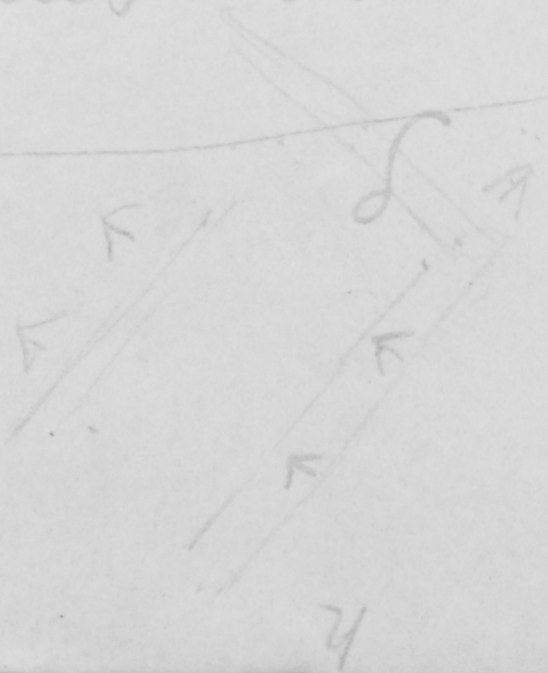 [dip and strike of beds] S N
[dip and strike of beds] S N
1 Obsolete term for soft clay-like mineral such as kaolin (OED).
2 Possibly one of the spiders listed in Zoology notes, pp. 44-6.
3 Possibly Gay 1833.
[back cover]

[inside back cover]
Bohn Coqu
C. Darwin
70 .74 N W
30.3971
70.5 beginning at 10 am 1.25 in ½ hour in 6' .38 of rain fell +12" 35 in 3hr 1.6 9-11° 1° :8 3 .54
1 Barometer reading.
[page 1b]
30. 368
28 58
centre West 1.788 Quail Island
[Mr Farrar Lesson]
Above Breccia from [time] the dislocation of parent strata a Greyish white sand with Turbo like Odontoma
4 feet thick
b a [coarser] with numerous shells c Beneath, a conglomerate of black feldspathic rocks with numerous shells & corals 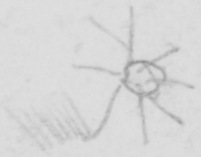
(a) about 4 feet thick
b about a foot spatangus1 perfect quietly deposited —
1 A heart-shaped sea urchin (echinoderm).
[page 2b]
N. W. of Island
(a) heaved up contorted together with inferior conglomerate: allowing a vein of superior breccia to descend
b & c much [trouble] beneath a [bright] red aluminous1 soft rock
Hard feldspaths
1 Meaning silicate minerals containing aluminium.
[page 3b]
rock 12 feet thick prismatic 5 sides having appearance with curved columns of stratification
Beneath (a) is a confused mass of decomposing rocks in which crystals are visible either red or yellow clay; upon which [rest] about a foot thick of tufa1 or carious2 rock Then feldspathic rock
1 Limestone formed chemically.
2 Decayed.
[page 4b]
all the latter appears to have undergone an upheaving viz after deposition; probably at same time that (a) was upheaved certainly
N by E end of island white sand made up of shells upon which rests carious rock1
1 Darwin recalled in his Autobiography, p. 81, 'The geology of St. Jago is very striking yet simple: a stream of lava formerly flowed over the bed of the sea, formed of triturated recent shells and corals, which it has baked into a hard white rock. Since then the whole island has been upheaved. But the line of white rock revealed to me a new and important fact, namely that there had been afterwards subsidence round the craters, which had since been in action, and had poured forth lava. It then first dawned on me that I might perhaps write a book on the geology of the various countries visited, and this made me thrill with delight. That was a memorable hour to me, and how distinctly I can call to mind the low cliff of lava beneath which I rested, with the sun glaring hot, a few strange desert plants growing near, and with living corals in the tidal pools at my feet.'
[page 5b]
then prismatic feldspar
between these & former ones hard white rock with yellow spots
heap of white balls beneath white sand.—
[page 6b]
carious
1 Feldspathic Lava
2 Overlying the white sand
3 beneath white sand
4 between Feldspathic & lower crystalline rocks [on] white sand
stone tufa
[page 7b]
by a well marked vein in lower rock prismatic crab in white sand
same process now going on shore living Iron found in it.
Upper breccia composed of lower rocks
[page 8b]
new breccia with both upper & lower feldspathic rock
containing iron some inches deep is it cemented by decomposition of neighbouring rocks
standing from [without wacke] Some contemporaneous of Dykes1 standing from [2 words illeg] running like trap dikes; upper divisions of prism filled with indurated2 sand withstanding weathering
1 A sheet of igneous rock which has been injected into the country rock from beneath.
2 Hardened. Sediments are often said to be indurated if they are cemented, for example by lime.
[page 9b]
I should think this coast one of short duration —
Sand white from decomposition of feldspar (?)
In places every rock is covered with pisiform concretions1
1 A hard lump of rock within a softer matrix. These are often caused by chemicals migrating through the rock and cementing the existing sediment.
[page 10b]
in places impossible to tell whether it is breccia of moden modern or older days.
Going for a hundred yards more South lower beds of white sand become filled with large boulders of lower rocks
[page 11b]
beneath this comes a line of another stratum; more soily & contains large & more numerous shells
A regular bed of oyster remains attached to the rocks on which
[page 12b]
they grew
Alternation of sand
boulders
[sandy & soily] sand
The lower carious part of Feldspar perhaps owing to expansive power
[page 13b]
of stream.—
Although in parts this old sea coast is 30 or 40 feet above present level of ocean yet in others the present breccia is again covering it
[page 14b]
owing to it having sunk again most likely as it agrees with that which has been raised What confusion for geologists.
coast crosses Island NE = SW.
On the E of island only appearing [proof] is is E on W. in W.
[page 15b]
Jan 18th. [1832]
Lower sorted beds full of Turritella1 much better seen in S of island Here the sand is only few inches thick, then the white concretion — then about 6 feet of rubbish
1 A genus of marine snail with high-spired shell.
[page 16b]
which looks as if it were cemented by mortar.1
At S end of island sand becomes finer & thicker not so full of organic remains Feldspathic 18 ft thick
Upper balls [taking] a concretion
1 Lime and sand cemented by water.
[page 17b]
form balls even 3 feet in diameter
Enl The upper rock in places has entangled the lower pyroxene1 rocks
When does Pyroxene occur ??
1 Silicate mineral such as augite often found in basic igneous rocks.
[page 18b]
procure more concrete masses
Aplysia hurts1
opposite Quail Island
beds higher than island. Carious & amygdaloid2
Augitic3 conglomerate amygdaloid with white matrix
confused mass of Porphy Augit Alum.
1 A species of sea hare of order Anaspidea. See Zoology notes, p. 18 and Journal of researches, p. 6.
2 Of almond-shaped cavities in volcanic rocks caused by gasses that were subsequently infilled by mineral precipitates.
3 As augite, a pyroxene mineral, occurring mostly in volcanic rocks.
[page 19b]
Amygdaloid.—
Signs of sand bank running the N E. but dipping in [wrong]. —
Concretions long Dyke = 18 inches wide, tortuous. Olivine1 porphyritic: running some 100 yards
1 A silicate mineral generally associated with basic igneous rocks such as basalt.
[page 20b]
found the line of coast, about 2 miles — beneath it are olivine or dyke &c
above describ[ed] —
Mortar like
running NW
Sand 2 30 ∠
curiously furrowed like sea coast
[page 21b]
something like top of Quail
Concentric amygdaloid ball more amygdaloid
Behind coast & beneath Feldspathic are the augite & olivine rocks
[page 22b]
Agency of water
Indentation in mountain
Pebbles not rounded
2 system of table lands
Quail Island
[the] [illeg] another succession of such
[page 23b]
rocks
Or Quail Island has sunk
Of course near the old coast land should be lower
[page 24b]
20th [January 1832] N of Quail Island —
Inferior table land
Diluvium1
crossed by another long valley: NW in the Baobob
Perpendicular of grey rock of feldspar & augite: new soil (1)
1 Deposits which have the appearance of having been laid down by floods.
[page 25b]
N 1 ?? . 1041
Sides of hill show great torrents on side crystalline rock (2) amygdaloid porphyritic
prismatic [trap] of feldspathic rock (3)
1 Added rock specimen number.
[page 26b]
Differences of augite & hornblende1 ??
4. White rock in stream
5. crystalline altered rock by side of this the higher table land is composed Dykes in upper crystalline rocks Red hill red lapilli2
1 An amphibole mineral.
2 Small fragments of rock blasted from a volcano (literally 'little stones').
[page 27b]
& concretion balls NE & by SW above 2 miles comes the chain of augitic hills like base of Quail Island
White magnesia1 quantity contains fragment of lapilli
origin of concretion
1 Magnesium-rich limestone.
[page 28b]
line of former coast // to the present
from NW. by W to S: ~ to E NE. & extent of lava from Red Hill |
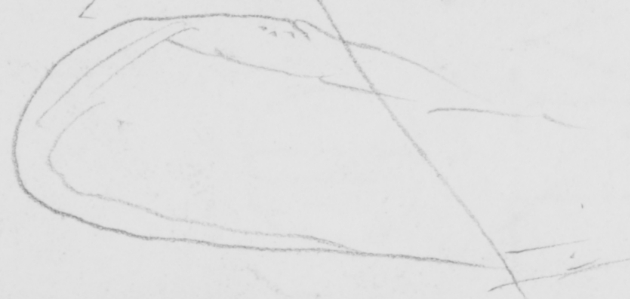 |
[page 29b]
Go to E beyond Praya to Hill
Coast shells & concretions & appear in line between Red Hill & F upon Augitic augiti rock & covered by felspathic rocks
signs of destruction & veins in [lower] rock
[page 30b]
Is the very centre of Island Augitic & the highest table land ???
Some rocks in Quail island have undergone a change [order] locality.
Upper Feldspathic
[page 31b]
23rd [January 1832]
Lumps of white conglomerate on [table] land of Feldspathic are [the] caught up //
Top Flag Hill & (2)
beds of rubbish — dipping alternation red carious rock & breccia with white matrix
54
8
35
38
25
160
[page 32b]
near here the covering of former coast 60 [feet] is very thick
Under flag hill the line of former coast is lower.
Must have been a previous [fern] hill
[page 33b]
cliff 200.
remarkable ravine
sea coast rest on conglomerate
[1] central augitic chain
great valley N & S augitic carious & covering conglomerate containing scoriae1 —
1 A solidified ash which is generally denser than water and has many gas holes.
[page 34b]
(2)
central chain with mica
[great] valley
pebbles of scoriae
Feldspathic rock
Jan. 26.th [1832] —
higher land between St Martin (1)
[page 35b]
Pap of scoriae. most regular cone
Surrounding country covered with blocks of this rock
rock beneath Red Hill much contorted
& covering of Feldspathic rock
[page 36b]
This cone situated in broad valley (2 & 3) of augitic rocks
2nd [February 1832]
Fuentes. Pap like hills, Feldspathic. what relation to covering?
Hill N of Praya red like red hill
[page 37b]
[northern white]
large hill Fuentes — alternate red rubble & Feldspathic
dipps NE & the [seven]
[page 38b]
3d [February 1832]
E coast Cellular rock exudes at the fi very first formation of coast
lower parts boulders decomposing augitic rock, with dykes
like under flag
has been cut through by instantaneous stream of water
[page 39b]
leaving bed of red lapilli &c
over which thin column curved & Feldspathic rock twisted.
in these parts the rotten rocks beneath FR. more preponderate
[page 40b]
wild cats. kingfisher Lizard Mac Cormick1
Lava perhaps first stream & more melted
Concentric Balls before lava red lapilli
1 Robert McCormick (1800-1900), Surgeon on the Beagle 1831-April 1832.
[page 41b]
appear to have come in direction of Flag staff hill bringing with it white stuff & red [lapilli] [rubble] red
Coast 90 feet thick.
Rock that
[page 42b]
overlies carious full of lime crystallised by heat in diverging
rays
Shells action under Blowpipe???
in [illeg] coast Conus1 Isocardia2 & [many] Ostrea3
1 A marine turret snail.
2 A genus of bivalve mollusc.
3 The oyster Ostrea sp., a bivalve.
[page 43b]
[Bottom most]
Milk for animalcule
Coast covered by running & leaping Crabs
[page 44b]
Ornithomya Salient Feronia Leach1
20th [February 1832]
Lower rock vitreous feldspar no. 1. prismatic
with acicular2 Hornblende.
distant peaks the same. —
No monocotyledon3 plants
1 See specimens 225-7 in Darwin's insects, p. 46, collected on St. Paul's Rock.
2 Needle-like.
3 A plant with one seed leaf, with parallel-sided veins and three-part flowers etc, such as grasses and orchids.
[page 45b]
Ants nest 3 feet high 2 thick with a tube at bottom
Lichen,1 mosses
Terns & noddy on trees alight
beautiful pink flowers on the top of mountain on trees
1 Specimen not in spirits 309 in Zoology notes, p. 372 'from the highest peak of Fernando Noronha'.
[page 46b]
vitreous feldspar & tufa alternate & dykes — white soil form beds
25th [February 1832]
Solitude on board
enervating heat
comfort: hard to look forward pleasures in prospect: do not wish for cold night delicious
Sea calm sky not blue
[page 47b]
Geology —
Abrupt valley. Barancas1
poor specimen of upper strata. melt. —
interesting parts NB
effects of [posterior] current (red line)
Upper strata
Trap-form dendritic2
1 A deep break or hole made by mountain floods, or heavy rains. Commonly used for a steep bank or ravine.
2 'tree-shaped', such as the layout of streams into a river or finely branching minerals in a rock.
[page 48b]
Reason for not think the sea has fallen
Pillars could stand on table-land
Lower rock very magnetic & all so
big hill show some appear of table
[page 49b]
land elevated
Tufa angular
During
Quail Island composed of more compact perhaps from being a mountain upper part of current
Amygalous with oblong cavities
[page 50b]
St Paul's Lava shore —
outer rock curious weather —
Mistake for dung
Vitreous feldspar crystal remains [outside] ?
Phonolitic [Fernand] Noronha
[page 51b]
Trap in do small crystals of vitreous feldspar [crossing] each oth not compact
Flag Staff Hill doubly submarine
Does not the cemented bed or diluvium prov water remain on it
[page 52b]
Perhaps the sea really formed the larger valleys.
line of elevation N of Quail Island not nearly so violent
oysters first appear
[page 53b]
on bed of boulders
Fernando
No volcanic influence East of Andes
Connexion of Trachyte1 with basalt2 interstratif ∴ of dyke & phonolite3 on each side Dyke [travers] phonolite
1 A fine-grained acid igneous rock.
2 A fine-grained, basic igneous rock. The predominant lava of oceanic islands.
3 A rock similar to trachyte that rings when hit with a hammer (sometimes also called clinkstone).
[page 54b]
& Trachyte hills most evidently appear of different origin from Pap-form hillocks
Effects of Pra table land to scenery at Praya
Vegetation on Fernando
[page 55b]
shows age
[W or R.]
Formation of dyke [or mine] from cooling & then cracking
[page 56b]
29th [February 1832]
Coast crystalline rock dip NWW
interstratif with bed of granite1 little mica constituent part arranged
in lines. chlorite sometimes in veins
These too pass into each other
Hornblende in weathered surface || layer crystalised ||
1 Coarse-grained acid igneous rock.
[page 57b]
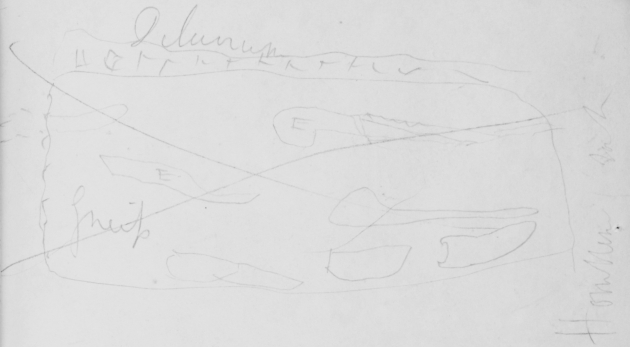
[gneiss in hornblende rock, diluvium above]1
Diluvium E E Gneiss
Hornblende rock
1 See the fair copy of this sketch in the geological diary CUL-DAR32.41v.
[page 58b]
Diluvium angular gneiss in red clay above where small covering of globular diluvium
Trap — stratified with Gneiss. — both crossed by a dyke of reddish granite —
[Much] conglomerate of the rock
[page 59b]
rather above present water [mark]
Crossing trap there a several of the hornblendic & + dykes sending off branched ones. — —
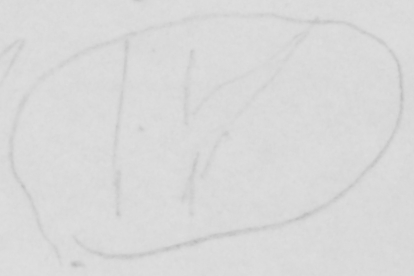
[branching dike]
the junction in all these like knife
[page 60b]
Cary. 80.2
Worthing 79
Cary 79.5
Jones 79.1
Cary 79.5 78.5
Regulator 76.5
Hygrom[eter]:
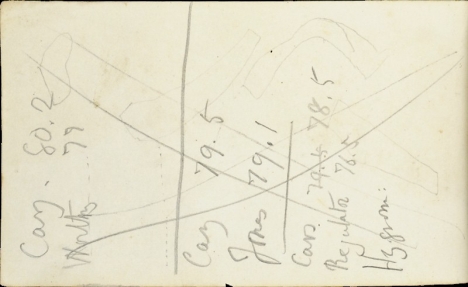
[page 61b]
Gneiss with little mica. ∴ nearly [Trap] in neighbourhood large crystals of hornblende
(Gloves)
[piece] of fine hornblende rock imbedded
Vide Plate
[page 62b]
Will the clay effervesce?
No
Vertical shale1 running SW by W [decomps] NW. by W
March 3d — [1832]
Temp of Spring 80°
1 A fine-grained sedimentary rock.
[page 63b]
King1 3 & Stokes2 4
5th [March 1832]
About 15 feet of mica then larger mass red clay with nearly verticle [streak] of a rock resembling [decompos] gneiss — dip N by W hornblende crystal & on the top bed of quartz
1 Philip Gidley King (1817-1904), Midshipman on the Beagle, 1831-6.
2 John Lort Stokes (1812-85), Mate and Assistant Surveyor on the Beagle, 1831-6.
[page 64b]
pebbles // then bed from valleys must be a 2 hundred feet thick
Spring 80 red clay 101 ½ in white sand 108 & spring 81
Quartzy vein, not very regular in clay
[page 65b]
blends with a [quartzose] gneiss
gneiss dipping regularly about 70° to NNW again
beds of reddish & [variegate] clay / carbonaceous matter / with hard veins crystaline veins no signs of deposition
[page 66b]
Iron sandstone1 dipping small 10 angle to the north from sea with beds of clay containing boulders of gneiss
I do not know if any differ from small formation or [if] [noone] go under the gneiss
1 A sedimentary rock made of cemented sand.
[page 67b]
The sea is now breaking down the strata
I suppose has undergone changes as it must have been once horizontal
[page 68b]
13th [March 1832]1
Conglomeratic gneiss trap syenite2 in a sandy (full of crystaline) base — alternation with ferruginous sand & green aluvium3 slate dip N by E 5° —
1 '13th' is presumably a mistake for 14th as the Beagle was at sea on 13 March.
2 Coarse-grained intermediate igneous rock.
3 Alluvium: associated with deposits laid down by rivers.
[page 69b]
line of contortion ? N by W
Veins of coal covered by hard sandstone — in green clay
[page 70b]
14th [March 1832]
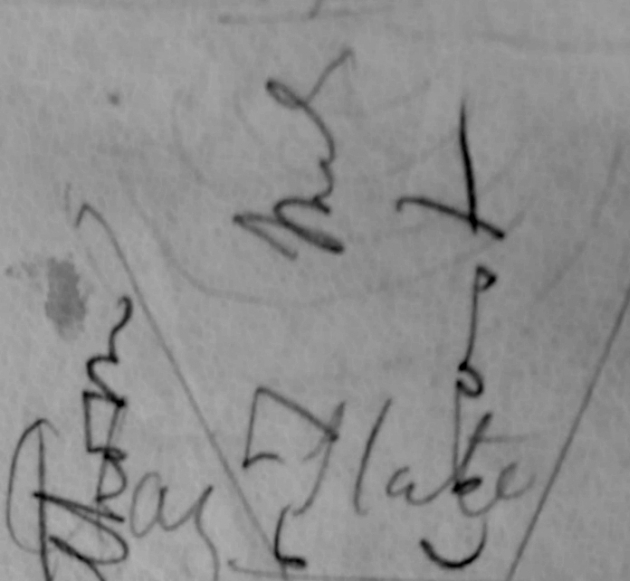
Clay Slate
20-30 fathoms extending 6 or 7 miles from the coast
[bare. beach. copy]
[page 71b]
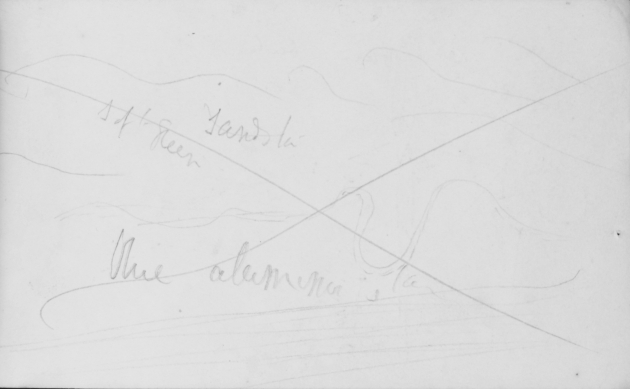
[green sandstone with contortion?]
S of green sandstone
blue aluvium
[page 72b]
rock like modern breccia dipping to N by W
Gen: obser: 15th [March 1832]
Small black ant putting everything to flight,1 — spiders & blattae2 in great agitation
1 See specimens 357-8 in Zoology notes, p. 29. Darwin's insects, p. 48, reports that the specimens have not been found but the ants were ''driver ants' (subfamily Dorylinae), probably of the genus Eciton.'
2 Cockroaches.
[page 73b]
A brick stopped their course
Spider 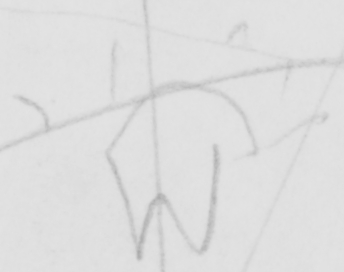 regular web
regular web
14° " 19 20' South
38° " 8 West
21st March [1832]
23d [March 1832]
[page 74b]
29 [March 1832]
4 o'clock
149/ no bottom
30/ at 4 bottom
N by W ∠ 12°
coarse [fine] sandstone incrusted:
↑↑ 90
27
63
[1 Lava] the dark
[page 75b]
Argillaceous1 beds
Whiter sand stone [illeg] no in lines
plates of iron
hexagonal [meaning]
cleavage of trap 2 & ½ W 2 & ½ N
1 Very fine-grained sediment such as shale.
[page 76b]
Basalt escarpement1 W by ½ S overlying sandstone. & & lifted up with it
— modern breccia
Columnar basalt with tufa, bears to other [illeg] SW by NE
1 A ridge of landscape where a harder layer of tilted rock has resisted erosion more than the layers above or below.
[page 77b]
Gneiss at Bahia & St Pauls Zoophyte1
May 9th [1832] Lagoa2
Red & white clay forming the rounded hill. [signs] of beds D SSE
Granite (?) Feldspar Porph concentric layers on the grand scale enormous block not [incumbent] vegetation landscape in [momentum]
1 A general term in Darwin's time for organisms which seemed to sit on the boundary between plants and animals, such as bryozoa, sponges, corals.
2 Lake or lagoon.
[page 78b]
3 salt water spiders
one in W B: [one] lengthened one [brown] rounded
hills running (Sugar loaf) W by S & N by E
15th [May 1832]
dip gneiss ESE ½ S
Hills ENE
19th [May 1832] — strike1 SSW 59° D ESE
gneiss fine grained beds. good observation.
1 The compass bearing of the horizontal line perpendicular to the dip.
[page 79b]
beneath porphyritic syenite — garnets edge well marked. —
[serpen] soil decomposed like Bahia process visible. — boulders & greenstone lying about
[page 80b]
[page in ink:]
6. 6. diameter circum small height 4.1 height 5.
6.4 diameter [illeg]
height 7 ¾ circum large
height 6 ½
if round. 1f " 2 ½
if square. 1f " 4 ¼
height 10 ¾
[page 81b]
June 2d. [1832] Inferior mica slate (Vide specimen) rock bed of about 6 inches of gneiss —
Superior gneiss abounding [patched] with mica & garnets: both something inbedded in large crystals of Feldspar
Running NE by N
I think the water have levelled this valley. hard mud dyke
[page 82b]
sky intense blue dead clear clouds at the Corcovado
fewness of bird swallows quiet. — general discussion on [rock] bird [beneath] &c
The [hardness] gneiss decomposing & covered by a more compact part, is is if where constituent parts
[page 83b]
of the gneiss are more abundant, that this rock most easily decomposes
Clouds passing over Corcovado & yet not stopping. —
Leucauge web tissue above rock1
Tetragnathus
Long Epeira2 near the water web vertical
Travellers too much seek contrasts
1 An orb-weaving orchard spider. See Zoology notes, pp. 38-9.
2 A spider of the genus Aranea
[page 84b]
shades in proportion so much darker
Scale in nature amongst spiders kept up by hymenop1 in absence of Carabid supplied by the Ants. —2
may after been less of insects & caterpillars
June 10th [1832]
gneiss dipping SW!
silence well exemplified
1 Hymenoptera: social insects (wasps, ants, bees etc).
2 This observation was published in Journal of researches, p. 39.
[page 85b]
rippling of a brook—
Lofty trees white holes. the pleasure of eating my lunch on one of the rotten trees — — so gloomy that only shean of higher enters the profound. — tops of the trees [entwined] cold damp feel
Textual notes to the Cape de Verds notebook
[IFC] page written perpendicular to the spine.
C. Darwin] ink, written parallel to the spine.
1.4] Down House number, not transcribed.
88202324] English Heritage number, not transcribed.
13/4…35] written parallel to the spine.
[1a] 2.8...32] written upside down from other entries on the page. page is heavily stained.
[2a] Don...Ponseca] not in Darwin's handwriting.
[6a] sketches drawn perpendicular to the spine, not in Darwin's handwriting.
[7a] sketch drawn perpendicular to the spine.
13…52] grey ink. [18a] Corcovado...not.—] ink.
[27a] sketch written upside down from other entries on page.
Then…(?)] written perpendicular to the spine.
[IBC] page written perpendicular to the spine.
'C Darwin' 'Bohn' and 'Coqu' written parallel to the spine.
in 34' 1.6] ink.
1] Barlow number, not transcribed.
[1b] [Mr Farrar Lesson]] written perpendicular to the spine, over other entries.
[25b] 104] added rock specimen number.
[60b] there are some marks that may be obscure sketches on this page.
[70b] Clay Slate] overwritten by '20-30...coast'. There is possibly a faint sketch of concentric semicircular lines radiating downwards below the date.
20-30...coast] written perpendicular to the spine.
[bare...copy] blue grey ink, written upside down from other entries on page.
[71b] sketch drawn perpendicular to the spine.
[74b] ↑↑] ink.
[80b] page in ink.
[The Beagle field notebook identifiers were re-set in January 2021 meaning the page counters were reset to 0. At that time this notebook had 17910 visits.]
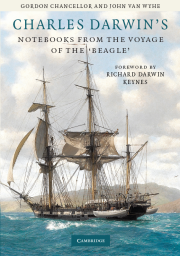 REVISION HISTORY: Scanned by Historic England. Transcribed by Gordon Chancellor, transcription typed and checked against microfilm by Kees Rookmaaker 7-8.2006, corrections by Chancellor, updated by Rookmaaker 11.2006, edited and corrected against colour photographs by John van Wyhe 5.2007, checked against the manuscript 4.2008. Transcription revised and edited by van Wyhe. RN16
REVISION HISTORY: Scanned by Historic England. Transcribed by Gordon Chancellor, transcription typed and checked against microfilm by Kees Rookmaaker 7-8.2006, corrections by Chancellor, updated by Rookmaaker 11.2006, edited and corrected against colour photographs by John van Wyhe 5.2007, checked against the manuscript 4.2008. Transcription revised and edited by van Wyhe. RN16






 [dip and strike of beds] S N
[dip and strike of beds] S N 






 regular web
regular web